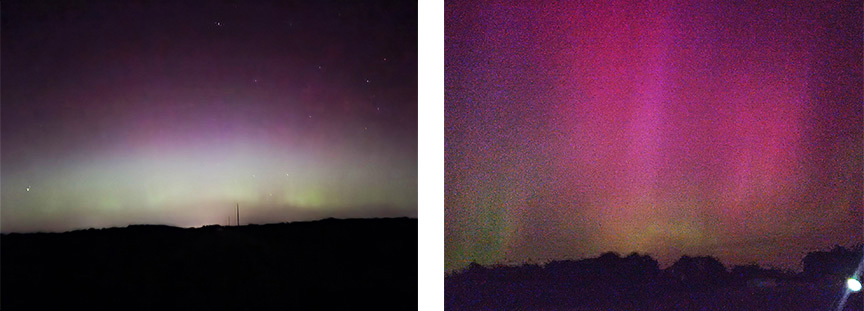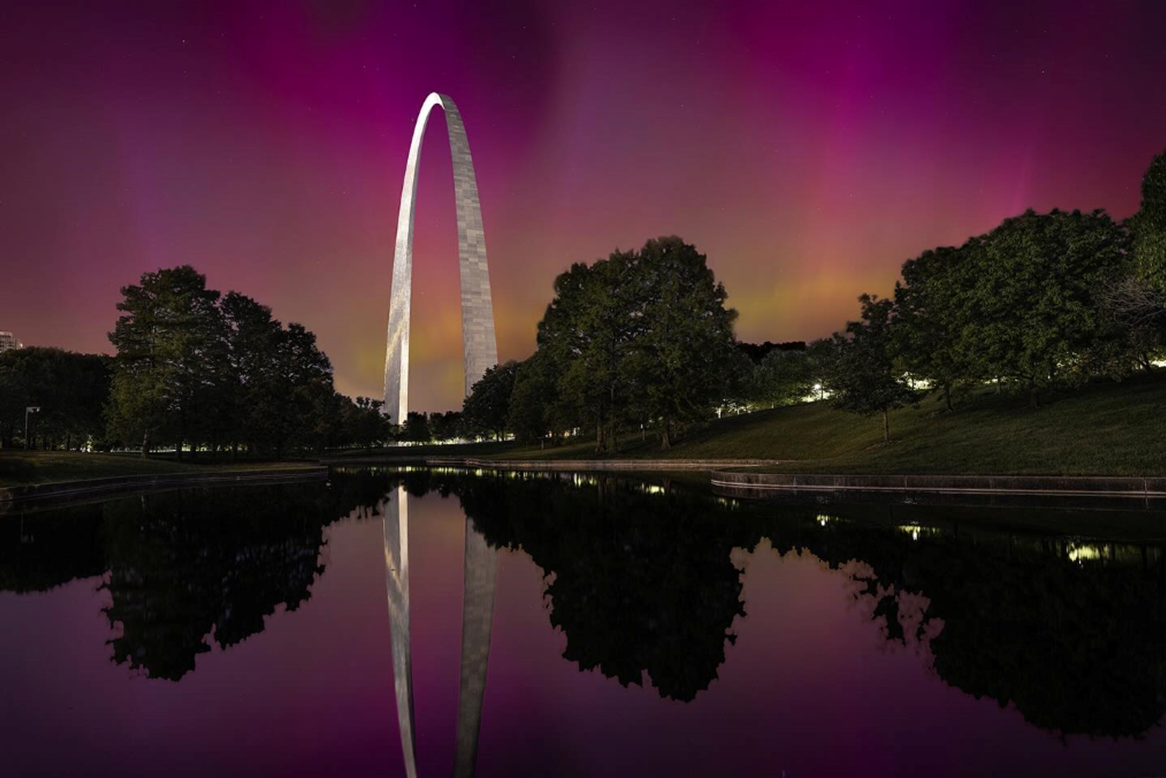AMAZING LIGHTS
On the afternoon of May 10, I made the following post to our Park’s main social media page:“From the Desk of the Sky Ranger: Northern Lights tonight, maybe…. There is a chance of auroral activity that could come all the way down to the St. Louis area. Try to find a spot that is pretty dark to the north to glimpse the rare, shimmering northern lights…"
Hopefully at least a few people were inspired by this post and saw the aurora that night. Those who did watch were rewarded with an amazing sight, depending upon when they looked and how many city lights they contended with. The display seemed to be strongest in the early evening hours, a few hours after sunset. I ventured out about forty miles east of St. Louis, and saw roundish glows, diffuse hazes, rays of light, and other features. Most of the time, the green color of the aurora was plain to see, but sometimes a pink or faint red was noticeable. Digital cameras are great at picking up and building up faint light and are sensitive to red light, as can be seen in some of my images displayed below.
The aurora is caused by charged particles that are emitted by the Sun and interact with oxygen and nitrogen gas in Earth’s atmosphere. Similar to how a neon light glows, this causes the gas to glow, forming the colors of the aurora. The Sun often has solar flares that spew out these particles, increasing the likelihood of displays of the aurora.

The Aurora Borealis is caused by streams of charged particles that came from the Sun, particularly during Solar flares. Image courtesy of NASA. Flares from Sunspot AR 3664, seen near the right edge of the Sun in the image, caused May’s stunning display of the Northern Lights. NPS Photo/RF
The Northern Lights are most often seen from close to the magnetic poles of the Earth- in the USA this would be near the Canadian border and Alaska. Auroras are common in those areas- in fact my wife saw them several times on a trip to the area in the 1990s- but become more and more rare the farther south you go. On occasion, extreme flares, or a succession of them cause the aurora to be seen much farther south. In fact, the May 10 display was glimpsed as far south as Guatemala, just 15° north of the equator!
There is an eleven-year cycle of solar activity that has been observed for centuries, with the number of sunspots, somewhat cooler parts of the Sun, increasingly greatly near the solar maximum. We are close to that point now. The magnetic activity associated with these sunspots makes them likely candidates to cause solar flares, so displays of the aurora are more common but are not limited to the solar maximum. The giant sunspot AR 3664 produced a series of flares that stirred up Earth’s atmosphere, causing the historic display.
All this was in the recent past. Could we be so fortunate as to soon see another display, visible in the St. Louis area? The answer to this question must be maybe, but probably not. A “perfect storm” of factors had to line up for us to see the May 10 show, which happened on a Friday night, when many people were oft the next day. Since we are near the maximum of solar activity, another series of flares or one enormous one, could happen, and probably will. Then it would be largely a matter of timing- if and when the particles from the flares reach Earth. Will this be when it is nighttime in St. Louis? Will the sky be clear? If the answer to either of these is “no” then we will not see the display, even if it is otherwise strong enough to be seen at the latitude of St. Louis. On May 10th, the crescent moon hung in the west during the evening, causing minimal interference with the aurora, but if the event happens near to full moon, the show will be severely diminished. The display might also occur only before dawn, when few people will be awake to see it. Another factor, the interplanetary magnetic field, which is not fully understood, can either influence the auroral displays to move in the direction of the equator or remain concentrated near the poles. The counterpart to the auroral borealis is the auroral australis, which is seen by our friends in the southern hemisphere.

Two images of the auroral display of May 10, as seen from about forty miles east of St. Louis. Pictures taken with a cellphone camera. The colors were much more prominent in the camera than they were to the unaided eye. NPS Photos/RF
Probably the main question to most of you reading this blog is “How can I see the next display, if we are lucky enough to have one in the near future?” Probably the first thing is to stay informed. The information posted on popular websites is sometimes incorrect, misleading, or not updated often enough. For example, it was posted by some sites that the stream of particles from the Sun would not arrive until the late evening or early morning of May 10, causing some people to miss the best of the display, when the best view was soon after dark. A semi-professional site such as spaceweather.com offers frequent updates and is a good source to follow and is also free to access. If you do receive word about a possible display, it is best to find a dark or at least fairly dark location if you can, as the city lights greatly reduce the spectacle. Find a spot that has an open view to the north. Not all displays are impressive- all you might see is a vague grayish glow towards the northern horizon but watch for a while. In fact, much like for a meteor shower, bring a lawn chair or blanket to lay on (bug spray too!). Changes can happen over minutes or hours, as can be seen in my pictures above. Use a night setting and a short time exposure to record the aurora with your cell phone.
If you have a DSLR camera, try using your widest lens (smallest focal length), set to your most open aperture (usually about F/2 or F/3) and take a lot of pictures. As mentioned in the beginning of this post, the colors of the aurora show up much better through the camera than with your unaided eye. Here are two of my best images of the aurora, taken with my Canon DSLR.
 Here are three of my best images of the aurora, May 10, 2024, as seen from near Okawville, IL. NPS Photo/RF
Here are three of my best images of the aurora, May 10, 2024, as seen from near Okawville, IL. NPS Photo/RF Finally, I offer this absolutely amazing image of the aurora as seen from the South Reflecting Pool here at Gateway Arch National Park, taken by local professional photographer Tim Farmer. With the unaided eye, due to the massive light pollution, all Farmer could see was a faint glow to the north, but with his equipment and skillful processing, he was able to produce this perhaps iconic picture. In about thirty-six years at the park, I never imagined I would see an image like this.

Photographer Tim Farmer’s iconic image of the Northern Lights. South Reflecting Pool, Gateway Arch National Park, May 10, 2024. Due to light pollution, the image has been processed to bring out the colors of the aurora. (Image courtesy of Tim Farmer)
Don’t miss our June 14 Gateway to the Stars program! Historian, archaeologist, and author Bill Iseminger will sign copies of his book, “Cahokia Mounds: America’s First City” at the Arch Store from 6:15-6:45 pm, followed by a discussion of the “Skywatchers of Ancient Cahokia” in the Education Classroom at 7 pm. Weather permitting, this will be followed by free telescope viewing, led by the Park staff and volunteers from the St. Louis Astronomical Society.
